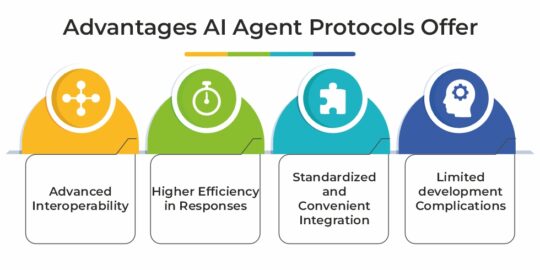Artificial intelligence (AI) has doubtlessly enhanced human-machine interaction, but do you know how AI agents interact with each other while efficiently solving tasks? AI agent protocols play a crucial role in this process. MCP, ACP, and A2A are among the leading AI agent protocols.
AI agents are gradually becoming a norm across various sectors, helping professionals streamline their tasks and deliver better results. AI agents, while enhancing efficiency in their responses, initiate collaboration with one another and other systems through specific communication protocols. Whether becoming more autonomous or enabling high-value assistance, these protocols empower AI agents to achieve their full potential.
In this blog, we’ll explain what AI agent protocols are and differentiate between the top protocols- MCP vs ACP vs A2A. Let’s get started...
What is an AI Agent Protocol?
AI agent protocol includes predefined standards or guidelines that AI agents adhere to when communicating with each other and additional systems. These protocols enable AI agents to collaborate effectively with one another while understanding, assessing, and addressing tasks together. Nevertheless, while standardizing communication, AI protocols do not control the agentic workflows or the decision-making processes of autonomous AI agents.
In brief, AI agent protocols establish the language and rules that enable AI agents to collaborate and exchange information effectively. These protocols outline the format, structure, and sequence of messages, as well as the communication conventions between AI agents, including the roles and response mechanisms of the agents.
Advantages AI Agent Protocols Offer
-
- Advanced Interoperability:
AI agent protocols allow agentic AI models to overcome the limitations of isolated systems or individual AI agents used by an organization, while facilitating seamless communication and collaboration among AI agents, other systems, devices, and environments.
-
- Higher Efficiency in Responses:
When AI agents interact and collaborate effectively with each other according to their roles and mechanisms, they execute tasks more efficiently. The responses they offer through active interaction are more operational with reduced flaws.
-
- Standardized and Convenient Integration:
AI agent protocols are standardized guidelines to enable communication between agentic AI models, considering the leading technologies. Hence, these protocols also contribute to the standardization of AI model development and deployment, ensuring compatibility with the latest technological advancements.
-
- Limited development Complications:
Protocols utilize software development kits (SDKs) to tackle the barriers of agentic communication. Such an approach offers the opportunity to design multi-agent models, allowing developers to upgrade pre-existing functionalities alongside establishing new features.
Before discussing the differences between MCP vs ACP vs A2A, let us understand these protocols separately...
Introduction to MCP
Anthropic launched the Model Context Protocol (MCP) in 2024 as a standardized convention. The protocol is set to enable AI applications to interact adequately with external platforms and systems, including files, tools, web searches, APIs, and databases. It discloses data through resources, tools, and prompts. While complementing agent orchestration frameworks like LangChain and BeeAI, MCP cannot replace them or know the purpose of a tool when it is called.
Instead of being an agent framework, MCP serves as a standardized layer for agent integration, enabling access to tools. So, we can definitely say that MCP facilitates standardized collaboration while optimizing tool integration. However, the LLM decides on which tools to connect with after assessing the user’s query and its intent.
Core Elements of MCP Architecture:
MCP host: Containing orchestration logic, the MCP host can manage multiple clients while enabling each MCP client to connect to an MCP server.
MCP client: While managing sessions, analyzing and verifying responses, alongside controlling errors, MCP clients transform user requests into a structured layout. Notably, each client has a one-to-one connection with the MCP servers.
MCP Server: MCP servers transform user queries into server actions. These are originally GitHub repositories with several programming languages, including Java™ and Python. Common MCP server integrations are web search, Slack, Git, and Docker.
Key Features:
-
- Vigorous memory management
- Interoperability
- Context compression
- Security and governance
Understanding ACP
IBM’s BeeAI introduced Agent Communication Protocol (ACP) in April 2025 as an open standard to advance agent-to-agent communication. It unlocks convenient collaboration across teams and technologies used within an organization. With capabilities of interoperability, scalability, and reusability, ACP transforms the disrupted environment of AI agents into effectively connected teammates.
ACP is often considered the next step after MCP, which demonstrates how AI agents function and collaborate. This AI agent model is capable of processing messages in different formats, including text, audio, image, video, and custom binary files.
Core Components of ACP:
ACP client: ACP client uses RESTful API over HTTP while forwarding requests to the ACP server.
ACP server: ACP servers assign tasks to appropriate agents while hosting one or more agents within a single HTTP endpoint.
Key features:
-
- Message standardization
- Ontology support
- Error handling
- Agent registry services
Explaining A2A Protocol
Google unveiled the Agent2Agent (A2A) protocol to redefine communication standards for AI agents in April 2025. Similar to BeeAI’s ACP, A2A is an open standard for collaboration between agentic AI models, enabling effective interoperability for multi-agent systems. This protocol aims to break the silos or communication barriers between AI agents. To fulfil this purpose, A2A works as a messaging layer that allows AI agents to literally talk with each other irrespective of their dissimilar agentic architectures.
A2A protocol follows three steps to function, starting from the discovery of appropriate remote agents after receiving a request from a human user or other AI agents. Up next, it authenticates the client agent to perform the task. The final stage involves communication between the AI agents, including sending the task, executing it, and returning the outcome to the client agent.
Core Elements of A2A Protocol:
A2A client (client agent): The A2A client or client agent serves as a key communicator, assigning requests or tasks to remote agents.
A2A server (remote agent): Remote agents accept requests, process them, and generate appropriate responses.
Agent card: It includes agentic AI metadata such as name, version, description, compatible data formats, authentication needs, etc., of an agent.
Task: Tasks are the requests that need to be solved or responded to. Tasks have unique IDs and describe the status of the request lifecycle, including submitted, working, input required, completed, and failed.
Message: Messages contain the actual content to initiate communication between AI agents. Hence, it includes the requests or tasks alongside the necessary descriptions for the same.
Artifact: Artifacts are the tangible elements required to complete the communication between AI agents, such as images, documents, videos, spreadsheets, and others.
Part: Part is a minor piece of information within an artifact. It can typically be of different types as they contain diverse types of data.
Key features:
-
- Decentralized communication
- Plug-and-play architecture
- Task-based messaging
- Cross-domain functionality
Real World Applications of MCP, ACP, and A2A Protocol:
Model Context Protocol (MCP): A healthcare AI agent connects with the MCB server to receive patient data while offering personalized telehealth recommendations.
Agent Communication Protocol (ACP): Several agents in a manufacturing setup communicate with each other to execute different activities in the manufacturing lifecycle.
Agent2Agent (A2A) Protocol: In a financial company, the A2A protocol enables communication between the process monitoring bot and the fraud detection agent.
Differentiating Between MCP vs ACP vs A2A
| MCP | ACP | A2A | |
| Developer | Anthropic | IBM | |
| Launch | 2024 | 2025 | 2025 |
| Key Focus | Model-to-model interaction and data integration | Agent-to-agent communication | Cross-platform agent communication |
| Communication | JSON-RPC over HTTP/SSE | JSON-RPC | Custom protocol with agent cards |
| Discoverability | No standardized discovery. | Discovery via dedicated endpoints or Docker registries. | Compatible with online and offline registry-based discovery. |
| State management | Essentially stateless at protocol level | Agent and client level state management | Thorough session-level, agent-level, and task-level management. |
| Development complexity | Minimal setup with single server file, including decorators. | Moderate with base agent.py file, including @server.agent decorator | Moderate with agent logic, main server, and executor. |
| Best usage | Increased individual model abilities | Connecting multiple agents | Cross-platform agent interaction |
| Security | Context visibility control | Authenticated exchanges | Rule-based validation |
Major Considerations to Choose AI Agent Protocols: MCP vs ACP vs A2A
While developing AI agents or choosing the appropriate AI agent protocol, developers must consider whether their business needs are being met. In this regard, thorough testing and evaluating use cases can be beneficial. The following are the key aspects to look after while choosing an AI agent protocol-
-
- Efficiency: The protocol you are choosing must allow AI agents to communicate effectively while executing requested tasks.
- Security: The communication between agents should be secured from common vulnerabilities and security threats. Hence, the communication protocol you are choosing must include robust access control, encryption, and authentication techniques.
- Reliability: The protocol should be reliable enough to function in any situation without failure, including unfavorable ones, like changing network connectivity.
- Scalability: The protocol should enable communication within an evolving AI agent environment while offering efficient performance and maintaining scalability.
Concluding Remarks!
The capabilities of autonomous AI agents are evolving significantly. While integrated into diverse industries, these agents not only detect weaknesses or challenges but also address them with effective strategies.
Lesser did we know that these agents use AI agent communication protocols to connect with each other and other tools while efficiently executing a proposed task. While thoroughly comparing MCP vs ACP vs A2A, it is evident that developers should adopt testing and assess compatibility when choosing the right protocol for their business.
Discover more transformative technologies and strategies with WisdomPlexus!
F&Qs:
Q: What is the difference between A2A and MCP?
Ans: A2A enables cross-platform agent communication. On the other hand, MCP helps AI agents to interact with other tools and data sources.
Q: What is MCP in AI agents?
Ans: MCP, in AI agents, is a standardized communication layer that allows AI agents to connect with and use external tools and data sources.
Q: Can ChatGPT use MCP?
Ans: Yes, ChatGPT supports Model Context Protocol (MCP). With its custom-built MCP servers, businesses can now link their in-office tools and data sources directly with ChatGPT.
Recommended For You:
Agentic AI vs Generative AI: A Comparison in Detail
Introducing Gemini CLI: An Open-Source AI Agent for Developers





